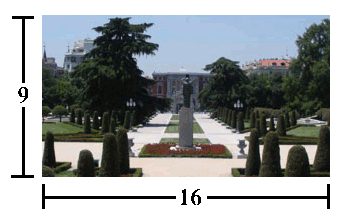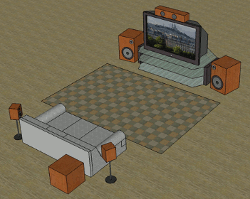3-D HDTV
With all the commercials on TV advertising 3-D HDTVs and movies it is clear that 3D is coming to a household near you, if not now then sometime in the near future.
TV manufactures as well as movie and television studios are betting that viewers like you and I will love it and that the 3D TVs will become the standard home television.
If you are in the market for a new HDTV then I highly recommend purchasing a 3-D HDTV instead of getting a regular (2-D) HDTV. The reason is because it should only cost a
few hundred dollars more now to get the 3D version instead of deciding later, after buying a 2-D HDTV, that you really would like a 3D TV. You can always buy the 3D TV and
just not watch anything in 3D if you like, but you will never be able to watch any 3D programming on a standard 2D television set (with the exception of anaglyph images,
the old red and blue lens glasses which distort the color we see resulting in a poor quality picture with this old technology). Many of the manufactures have cost in mind
and therefore don't include any 3-D shutter glasses in an effort to keep the costs as low as possible.
|
Home TV ServicesLooking to upgrade your current cable or satellite service provider or find a better price then you're currently paying? In the process of moving and not sure which providers will be available at your new location? We can help! Simply complete the form below in order to see what services are available in your area and compare prices and current specials between competitors in your area.Find services available in your area.
So what are you waiting for? Check now to see if you can get all your current channels at a price that is lower than what you are currently paying. Also, be sure to check for all services and prices available in your area including: TV, Internet, Phone, Home Security, Home Improvement, Insurance, Moving, and Home Warranties. |
HDTV InfoHDTV stands for high definition television which is similar to regular old television now commonly known as SDTV or standard definition television. There are however, two major differences between the two. HDTV has a far superior picture quality over SDTV. This is achieved by broadcasting at a much higher resolution. The second major difference is that the size and shape of the screens are different. This is called the aspect ratio. HDTVs have a screen aspect ratio of 16 by 9 (widescreen) while SDTVs have a 4 by 3 ratio as seen below.  4:3 Aspect ratio of an old standard definition television screen.  16:9 Aspect ratio of a high definition television screen. Pictures showing the difference between 4:3 and 16:9 aspect ratios of standard and high definition televisions. The main difference between HD and SD, and the reason many people are switching from their standard definition televisions to large high definition televisions is the superb resolution and picture quality offered by HDTVs. In order to simplify how the two different TVs work we will say that SDTVs have 480 vertical lines of pixels and around 640 horizontal lines of visible pixels (pixels are the colored dots that make up the picture displayed on the screen) for a combined total of 307,200 visual pixels for any one frame (one still shot of the picture on the screen or basically a paused image). This may sound like a whole lot of pixels but in reality the number is nowhere near as big as it sounds. An HDTV however, has a display combined form up to 1080 lines of vertical pixels and 1920 lines of horizontal pixels for a total of 2,073,600 pixels. This makes it rather easy to understand the difference in picture quality between SDTV and HDTV and provides the stunning images that are possible on HDTVs. In order to watch an HDTV program on an HDTV there are a few requirements. Obviously you need an HDTV or HD monitor in order to watch HDTV. You will also need: An HD source. This can be an HD broadcast service such as satellite or cable service or even an HDTV over-the-air broadcast transmitted in HD. An HD Channel is also needed. Just because you pay for HD service, through a provider such as DirecTV, doesn't mean that every channel is broadcasted in HD, so be sure to find a channel that is broadcasted in HD. Also, even though you have your HDTV tuned to an HD channel this still doesn't guarantee for an HD picture. You will also need An HD Program. Not all shows and movies on HD channels are broadcasted in HD. For example, if you are watching an old program that was originally recorded on SD video tape there is no way that it can be made into HD; however, if it was recorded on film, which most show are, then the program can be and often is turned into a high quality HD show. For more information on HDTV check our full HDTV article. |
HD AudioAudio setups for home theater systems come in many different configurations usually depending on the owners room conditions and preferences and the main constraint for most, the owners finances. The cheapest system might just include the TV and its built-in speakers while one of the best top of the line system can cost upwards of $100,000. So where do you begin? Let's start with speaker setup and getting the best sounding from your current speakers. Typical 5.1 surround sound configuration. In order to get the best sound from your speakers they should be placed at eye level which is approximately the same level as your ears. In order to position them at the right height speaker stands are often used in order to raise smaller speakers off the floor to a more acceptable height. The center speaker, however, is often impossible to center at the correct height since the television is usually in the way. In this case position the speaker either above or below the TV at which ever position is closer to the height of your ears as long as there are no obstructions such as coffee tables or ottomans in the way. If so, above the TV may be your best bet. There are wall mounts available to mount the speakers to the wall and also mounts that can mount speakers directly on-top of the TV. But if you really want to go all out you can get in-wall speakers which are speakers that are mounted within the walls with speaker grills painted the same color as the walls to make the speakers even less visible. The rear speakers, in a typical 5.1 Dolby surround sound system, are often positioned above ear level (at ear level when standing is a good height) so that they don't over power the front speakers and are often positioned towards the center listening position at 90 to 110 degrees as seen in the picture above. And lastly, the subwoofer can be placed virtually anywhere in the room; however, a corner is often the optimal location. For more information please check out our home theater audio page. |